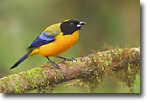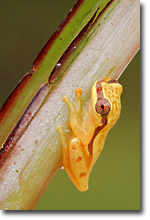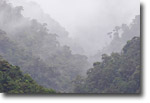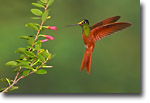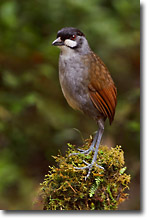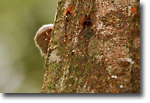Nature Photography In Ecuador |
|
Imagine a country that is roughly the size of Colorado and supports over 1,600 species of tropical birds, 4000 species of intricate orchids, hundreds of species of colourful frogs, dozens of species of primates and countless species of fascinating insects. Imagine a country where you can visit pristine cloud-forests, beautiful beaches, snow capped mountains, and remote areas of the Amazon rainforest. Imagine that this country has relatively good roads, a well equipped tourism infrastructure, a stable government, and can be reached in less than 8 hours from most of North America. If you visit Ecuador you can stop imagining, reach for your camera, and start photographing the unbelievable biological riches of this incredible South American country.
When To Go?
One of the great things about visiting Ecuador is that there really is no bad time to visit. The Amazon is generally wet but is driest from November to February. Otherwise, most of the country experiences a rather stable climate for much of the year with oscillating periods of rain. I visited Ecuador between January and June and found this to be an ideal time as it was the low season for tourism.
What To Bring?
Ecuador can be a tricky country for which to pack. The weather up on the slopes of the Andes can be cool or even cold and in the Amazon or on the coast it will be hot and humid. I find that the best option for clothing is lightweight technical hiking apparel that dries quickly and can easily be layered for added warmth. Long pants and shirts will also help to protect from the harsh tropical sun and bugs. Good rain gear is a must!
Because Ecuador is a country that is so rich in nature photography opportunities, you may find yourself shooting much more than you would expect. Be sure to bring sufficient storage for all of your digital files and a means to back these images up. Also, make sure to bring spare batteries for your camera and flash as well as any necessary chargers. It may be difficult and certainly will be expensive to acquire these items in Ecuador.
The tropics can be pretty harsh on camera equipment. Because of this I would recommend bringing two camera bodies in case one decides to fail. If you plan to photograph birds - it’s best to bring your longest lens. A 500mm f/4 is ideal but a 300mm f/2.8 with both 1.4x and 2x tele-converters also makes for a very versatile option. I would also recommend bringing along a wide angle zoom and macro lens. You will use them both! The frequent overcast conditions on both slopes of the Andes and the dark conditions of the forest understorey make a tripod a necessity for achieving sharp photos. Another invaluable accessory is a flash armed with the “Better Beamer” flash extender.
Transporting all of your gear is most easily done using a good quality photo backpack. For Ecuador I would recommend bringing a rain cover for your pack, large zip lock bags with silica gel to protect your gear in humid conditions and a small day pack for items such as water, a raincoat and your lunch. If you aren’t fluent in Spanish a phrase book would also be a good idea as English or other languages are not spoken in most of Ecuador.
How To Get There And Around
Most tourists fly in to Ecuador’s capital of Quito in the central valley. From here, domestic flights can take you to either Guayaquil or Cuenca if you are heading to the coast or the south. Once in Ecuador, you will have to decide whether to take part in an organized tour, to rent a car or to get around by bus. This choice depends of course upon your budget and also on whether or not you speak Spanish. If you do not speak Spanish, and are pressed for time, than I would not recommend the latter option. However, it should be noted that for those on a budget all of the places mentioned in this article are reachable by public transit. If you do decide to take part in a tour there are numerous options ranging from private guides to birding or nature tour groups. A quick Google search or scan through a birding magazine should reveal plenty of options.
Places To Go
Ecuador’s landscape is so varied and each region supports completely different bird and animal life. Even though it is a small country, most people who visit for 2-3 weeks generally choose not to try and see the whole country. I think that this is wise as each region has so much to offer. I have listed my favourite places in each part of the country below.
- The Northwest - The Mindo/Tandayapa Valley area is deservedly a very popular part of the country for nature lovers. The cloud-forest covered slopes of the Andes are unbelievably beautiful and absolutely full of birds and other wildlife. The hummingbird feeders at Tandayapa Bird Lodge that host up to 20 species are not to be missed! The Mindo Loma reserve is also an excellent option.
- The Southeast - Copalinga nature reserve (located just south of Zamora) is without question one of my favourite places in all of Ecuador. With a network of good trails, easy access to Podocarpus National Park and the famous “old Loja-Zamora road”, knowledgeable and friendly owners, comfortable lodgings and great food I’m sure that you will love it too.
- The Northeast - Wildsumaco lodge is a bird lovers paradise and is home to species that are extremely difficult to find elsewhere. The network of trails here is impressive and there are fantastic hummingbird feeders. Guango Lodge would be another excellent choice in this region with a completely different set of birds.
- The Sierra - Although biodiversity is definitely lower in the highlands, the animals that do chose to live in these often harsh places are very special. The weather can be nasty, but on clear days the views are absolutely breathtaking. In the north I recommend visiting the Antisana ecological reserve and in the south Cajas National Recreation Area.
- The Southwest - The Buenaventura reserve is run by the Jocotoco conservation foundation – a group that seeks to conserve habitat for threatened and endangered birds. All of their reserves (including Tapichalaca, Utuana, Jorupe, Yanacocha and Canande) are worth visiting. Buenaventura has fruit feeders for tanagers and some of the best hummingbird feeders in Ecuador.
- The Oriente - Unless you have been into the Amazon rainforest on a previous trip you absolutely must visit. It will be hot, humid and rainy and photography will almost certainly be difficult. But the experience of being in one of natures truly wild and sacred places simply cannot be missed. Most of the tourism in Ecuador is focused around the Napo River and there are a number of upscale lodges worth visiting (e.g. Sani Lodge, Napo Wildlife Center, etc).
Note – I have decided not to include the Galapagos Islands in the above list and stick to mainland Ecuador.
Top Photographic Targets
It is mind boggling just how much there is for a nature photographer to pursue in Ecuador. It doesn’t matter if you are interested in birds, plants, mammals or landscapes – you will find plenty of opportunities. Here are just a few of the top photography targets for Ecuador:
- Tropical Birds: I believe that Ecuador is the best country in the world for bird photography. It has the most bird species per square kilometer of any in the world by far. And with all the tanagers, toucans, antpittas and trogons out there - there are plenty of cool ones to chase after.
- Antisana Or Cotopaxi Volcano: On a clear day these two volcanoes (each over 5700m) can be stunning and extremely photogenic.
- Hummingbirds: Boasting well over 100 species of these charismatic little dynamos, Ecuador ranks second to only Columbia in terms of overall diversity. With the increasing number of lodges in Ecuador that are placing feeders on their grounds there is no better country to see and photograph them.
- Poison Frogs: The lowlands on both slopes are home to these colourful amphibians. The best place however is deep in the Amazon.
- Butterflies And Moths: There are unbelievable numbers of species that come in all colours, sizes and shapes.
- Orchids: Once again, Ecuador is home to more species of these unique flowers than anywhere else in the world. Collections of orchids can be found in the botanical gardens of many cities (including Quito, Loja and Mindo).
- Monkeys: Primate diversity reaches its peak in the Amazon. Head to the canopy towers of either Sani Lodge or the Tiputini Biodiversity Station to see the greatest number of species.
Conclusion
Simply put, Ecuador is a nature photographer’s paradise. If you are thinking about a destination for your next photography trip it would be hard to find a better location.
Comments on NPN nature photography articles? Send them to the editor. NPN members may also log in and leave their comments below.
Glenn Bartley is a professional nature photographer who focuses on photographing birds in their natural habitat. He resides in Victoria, British Columbia on Canada's West Coast. Glenn leads instructional photography workshops to exciting destinations around the world. To find out more or to see more of Glenn's images please visit www.glennbartley.com.
